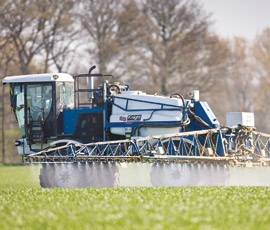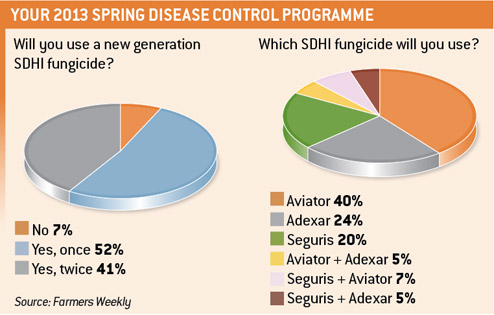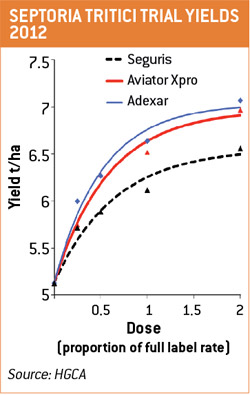Disease control is a priority with grain prices high

With grain prices high, growers are being urged to make disease control a top priority this season and not cut corners on fungicide spending.
After a difficult autumn drilling season, farmers are advised to look at maximising the potential of cereal crops this spring to cash in on firm grain prices.
That is the key message from senior researcher Jonathan Blake at consultant ADAS, who says farmers tend to stick to a premeditated budget during the season.
“With current wheat prices above or around £190/t it is well worth chasing every last potential yield boost,” Mr Blake told Farmers Weekly.
He says there will be huge variations in crops – field to field and regionally – resulting in contrasting disease pressures, so it will be about assessing risk in each situation.
The risk of foliar disease will be based on sowing date, crop density, varietal susceptibility and, of course, diseases present, while the risk of stem-based diseases such as fusarium and eyespot can be deduced from soil type and previous cropping.
Where early-drilled crops are looking forward, akin to a “normal” year, Mr Blake advises the use of robust strategies to minimise yield loss to disease and maximise the potential of the crop.
These should take account of the lessons of last season, but be flexible enough to be adjusted based on disease pressure through the season.
“Septoria is likely to be the key threat in those ‘normal’ crops, but in the later drilled crops – of which there are many – care will need to be taken.
“The goalposts may change, with mildew and rust becoming prominent in those less advanced situations,” explains Mr Blake.
In most cases, when considering crop inputs, there is an economic optimum that it would rarely be advisable to breach.
Actives
- Adexar – epoxiconazole + fluxapyroxad
- Aviator – prothioconazole + bixafen
- Proline – prothioconazole
- Seguris – epoxiconazole + isopyrazam
- Tracker – epoxiconazole + boscalid
However, Mr Blake believes in the current climate, the fungicide spend to achieve the optimum margin over fungicide costs is higher, and beyond the optimum, the drop off in margin is less.
The shape of these curves is different due to the high wheat price. They now appear to “plateau” at the top, as the additional yield achieved by applying more fungicide is covering its costs.
“Ensuring good control and maximising every last drop of yield potential will pay dividends this year,” he notes.

Product choice
Mr Blake says yellow rust is as much a threat in late-drilled crops as early, so growers should apply an azole or strobilurin-based T0 early season March spray on the susceptible cultivars. Where varieties are susceptible to septoria, chlorothalonil should also be included.
The backbone of a grower’s disease control armoury, the triazoles, should underpin the strategy for T1 April. Triazoles are part of the azole group of chemicals.
The two triazole mainstays of prothioconazole and epoxiconazole remain the strongest actives in a normal septoria disease year.
New SDHI products have been introduced over the past two seasons primarily aimed at the T2 May spring spray timing and used with triazoles in products such as Aviator, Adexar and Seguris.
“I think there is a case for using an SDHI at T1, if septoria pressure was similar to 2012, as they would give you more curative activity on leaves 3 and 4,” says Mr Blake.
“I would be including a multi-site again at this timing, with not much to choose from between chlorothalonil and folpet. Chlorothalonil proved stronger on septoria last year, but folpet has some useful activity on brown rust,” he adds.
Where Aviator is being used at the T1 timing, there is a case to use folpet, due to the antagonism issues when mixing with cholorothalonil, adds Mr Blake.
Any stem-based disease risk needs to be considered at T1, and where eyespot is causing concern, Tracker is the most effective option as the triazole-based product includes an older SDHI, boscalid.
However, Mr Blake points out that prothioconazole runs Tracker close and where stem-based fusarium is also a target, Proline would be the obvious choice.
“Whichever choice is taken, based on the slide in field performance of azoles, growers should not assume they will get effective control of septoria from half label rates of azoles. In many cases three-quarter rate or more of prothioconazole or epoxiconazole may be required,” warns Mr Blake.
Flag spray
The flag leaf May spray at T2 is the most important fungicide application and many growers are convinced of the effectiveness of the new SDHIs at this stage.
All HGCA trial data shows the effectiveness of Aviator, Adexar and Seguris (see graph) in curative and protectant situations, giving improved “kick-back” to treat any infection on leaf 2 or lower.
 “The azoles have seen declining efficacy and can no longer be relied upon and based on all the available evidence, T2 sprays should now consist of an azole, SDHI and a multi-site active such as chlorothalonil,” says Mr Blake.
“The azoles have seen declining efficacy and can no longer be relied upon and based on all the available evidence, T2 sprays should now consist of an azole, SDHI and a multi-site active such as chlorothalonil,” says Mr Blake.
He adds that Adexar and Aviator are clearly the best products on septoria both protectively and curatively. However, Adexar, with its epoxiconazole partner, is slightly stronger on rusts.
Seguris remains a very good protectant, he notes, so may sit more comfortably at the T1 timing, but would be effective as a flag leaf spray where septoria has been adequately controlled at T1.
Powdery mildew has the potential to be much more prevalent in late-sown crops this year even in resistant varieties, warns Mr Blake, and a specific mildewicide may have to be included.
“Proline is the strongest of the regular products on mildew. However, with the risk much higher in the late-sown crops the extra cost of a specific product can be justified,” he concludes.
A new generation of fungicides offer better disease control
SDHIs, or succinate dehydrogenase inhibitors, are a new generation of fungicides with strong curative and protectant activity against Septoria tritici, the main yield robber of UK wheat crops.
The new SDHIs are used as preformulated products along with triazoles such as Aviator, Adexar and Seguris to try and prevent disease resistance problems.
DuPont has announced that its SDHI active, penthiopyrad, will be available in three formulations – as a straight or partnered with chorothalonil or cyproconazole.
It is still unclear when the product will be commercially available, but DuPont are confident that it will be approved ahead of the start of the spray season.
Trials have indicated that efficacy of penthiopyrad on septoria is equal to the two leading SDHI products, Adexar and Aviator, with excellent curative activity on the disease.
DuPont’s Mike Ashworth believes the flexibility of the range of products will also be attractive for growers and agronomists.
“All three can sit comfortably at both T1 and T2 timings and the flexibility to tailor solutions in the face of changing disease pressure will be a big advantage,” says Mr Ashworth.
This is something ADAS’ Jonathan Blake has also asserted, with last year being an example of when the new range of products could have provided growers with the tools to respond to a disease explosion.
“Where azole products had already been acquired ahead of T1, a simple addition of a penthiopyrad product would have vastly improved curative septoria activity in response to disease outbreak. The pre-formulated products don’t allow you to do that.
“The azoles simply weren’t enough on their own at T1 last year,” explains Mr Blake.
Mr Ashworth points out the cyproconazole formulation will be very strong on rusts, but he still believes it will have to be mixed with one of the stronger septoria active triazoles, prothioconazole or epoxiconazole.
“Cyproconazole does have some activity on septoria, but will need one of those partners to boost efficacy,” he says.
Cost comparisons for SDHI fungicides
With very little to separate the leading SDHI products, price will be a big factor when deciding which one to use.
In 2012, BASF priced Adexar above Aviator and Seguris at £34/litre. However, early indications show that Adexar will be coming down to a more competitive £30/litre for 2013.
Independent sources also suggest that Bayer CropScience will not be changing the price of Aviator from last year’s £32/litre, with Syngenta’s Seguris being priced at £30/litre.
However, independent agronomist Paul Sweeney reminds growers that it is not just about price, but also crop response (see graph). He believes both leading SDHIs Adexar and Aviator are excellent fungicides.
“However, a full dose of Aviator will get you a better crop response than a two-thirds dose of Adexar, but would be the same price,” says Mr Sweeney.
“I believe Aviator still represents the best value for money, particularly in some of the mediocre crops that we have this year.”
For advice on your fungicide strategy, see our “Fungicide management in cereals” course in our e-learning zone. It includes planning and implementing wheat fungicide programmes and advice on targeting key diseases. Take the test and earn CPD points at academy.fwi.co.uk
Read more articles on fungicides
Four new fungicides to tackle oilseed rape disease
Early fungicide spray can keep barley diseases at bay
Higher spend pays off in tough disease year
Triazole troubles will bring disease control headaches

